The first place among treks in Italy undoubtedly belongs to the Via Francigena. The route originates in Canterbury, England, crosses France and Switzerland and finally enters Italy via the Gran San Bernardo pass. The Francigena originated as a pilgrimage route that crosses the whole of Europe vertically and has Rome as its ultimate destination.
Although its religious vocation is undeniable, the Via Francigena was travelled over the centuries by different types of people: by merchants transporting their goods through the various European kingdoms, by medieval soldiers and by scholars on the Grand Tour.
Today, the Via Francigena is travelled every year by thousands of tourists who, following in the footsteps of pilgrims, wish to discover the beauty of Italy. In fact, walking the Via Francigena means discovering Italy calmly, day by day, step by step, and learning to love it in all its aspects, from the artistic to the naturalistic ones, as much for its villages, castles and churches as for its forests, plains, mountains and hills.
In this article we want to tell you about a section of the route through Tuscany: from the ancient village of San Miniato to the wonderful city of the Palio, Siena.

Walking implies that at every step the world changes in some aspect and also that something changes in us.
Before departure
.jpg)
Here are some tips on how best to prepare for your walk along the Via Francigena in Tuscany. This stretch of the Via is not particularly difficult to walk, whether you are travelling with children or are not experienced walkers. The difference in altitude is not great and there are frequent villages where you can refresh yourself.
However, you must not forget that this is still a trek of at least 6 hours a day, so prepare your rucksack with care, choosing suitable shoes, carrying blister plasters, a mackintosh, suitable sun cream and a water bottle. Try not to put unnecessary items in your backpack, always better to travel light!
Before leaving, we also advise you to obtain your Pilgrim's Credentials. This is a booklet provided by the European Via Francigena Association on which you can place a stamp each time you reach a new stage: there are many bars, restaurants and tour operators that have the official stamp.
Another tip is to download the Via Francigena App. It will be very useful both for planning your itinerary and, during the walk, to know exactly where to go, which directions to follow and which way to turn at each fork.
Especially around holidays, we advise you to book places to stay at least a month in advance. Some of these villages are not very large and places to sleep are scarce. If you can't find a hostel in the city, you can opt for a farmhouse in the countryside: by contacting the owner you can arrange a ride.
The best thoughts I had were while walking
San Miniato – Gambassi Terme

San Miniato
The beautiful village of San Miniato arose around an 8th-century church to be the seat of the imperial vicars who controlled Tuscany. The castle of San Miniato had the task of controlling not only the Via Francigena but also the Via Pisana and the course of the Arno river. In this beautiful village, you can admire the tower dedicated to Emperor Frederick II who stayed in San Miniato, the 13th-century cathedral and the medieval fortification where Matilda of Canossa was supposedly born.
Starting from San Miniato you leave the Arno valley behind and enter the Elsa valley. When Sigeric, the archbishop of Canterbury, to whom we owe the birth of the pilgrimage, arrived in these areas, he decided to slow down his walk: the wonder of these places led him to walk more slowly.
This stretch of road is particularly fascinating for the hilly views it offers. Walking along the ridge, the view sweeps far across the valley and the spectacle of the Tuscan hills hemmed in by cypresses is truly phenomenal.
Along the route you will find several refreshment points, drinking fountains and benches, as well as some beautiful farmhouses owned by important Florentine families. Remember, however, if you are walking the Via Francigena in summer, that this stage is completely exposed to the sun: here you will find no woods, no shade, and no small villages in which to refresh yourself
The two main stops not to be missed during this stretch are the Pieve dei Santi Pietro e Paolo in Coiano and Santa Maria in Chianni. The former has a sandstone façade with interesting Romanesque elements and is located directly opposite an ancient small castle used as a customs post. The parish church of Santa Maria a Chianni, on the other hand, is a 12th-century construction by craftsmen from Volterra, characterised inside by anthropomorphic capitals on monolithic columns.
This stage is almost all on level ground, except for the last and notable climb to the village of Gambassi Terme. You will walk about 25km.
The meaning of the quest lines in the journey made and not in the destination; the purpose of travelling is the journey itself and not the arrival.
Gambassi Terme - San Giminiano
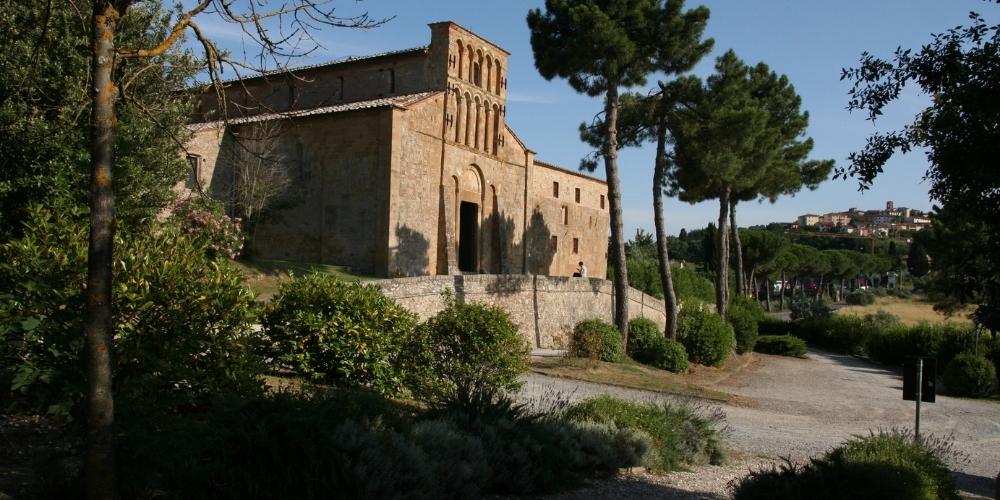
Gambassi Terme
Gambassi Terme stands on a hill, formerly inhabited by Etruscan communities. In the Middle Ages, a castle was built here by the bishops of Volterra. In the 12th century, a new castle was built in Gambassi Terme, a symbol of communal independence that was long disputed between Volterra, San Giminiano and Florence. Here you will also find the Terme della Via Francigena, which makes use of a spring of salso-bromo-iodine water: there is a swimming pool, a sauna and wellness paths.
This section is commonly recognised as one of the most beautiful of the entire Via Francigena in terms of landscape. You will walk along white roads lined with olive and cypress trees, pass by old farmhouses converted into luxurious residences and walk along the famous Chianti hills. If you are lucky enough to make this trek in spring, your every step will be accompanied by the chirping of birds and the intense scent of flowers.
Among the notable points you will pass through are the Sanctuary of Pancole, dedicated to Mary Mother of Divine Providence, a place founded in 1668 after a shepherdess mute from birth regained her speech after an apparition of the Madonna. Another remarkable place is the Pieve di Cellole: after a long period of restoration, it now houses a monastery and can be visited again. Here you can appreciate the simplicity of the Romanesque style and the beauty of the geometric motifs.
This stage is rather short and easy: it is only 14 km with little altitude difference. Many decide not to stop in San Giminiano but to go as far as Colle Val d'Elsa, in a single stage of about 30 km. The choice will be entirely yours: choose according to the time you have available and how many hours you want to dedicate to visiting San Giminiano.
Abandon the big roads, take the paths
San Giminiano - Colle Val d'Elsa
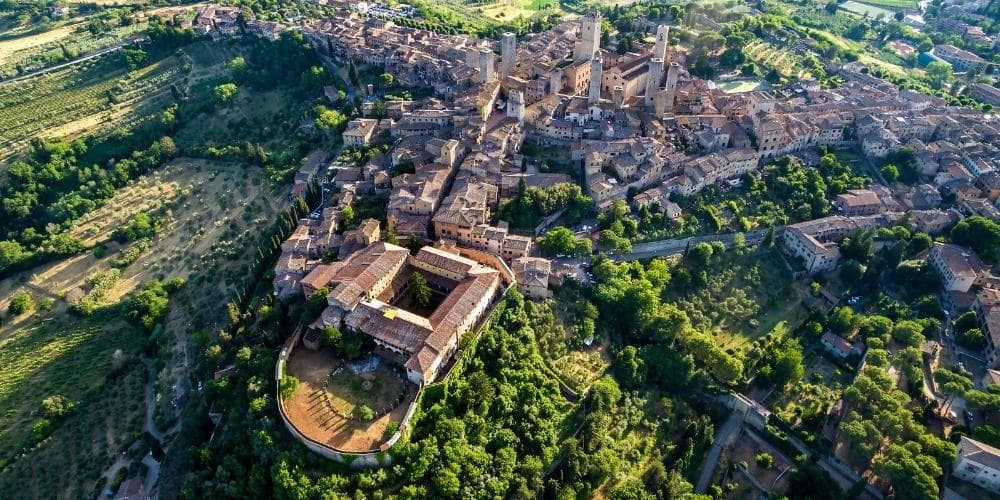
San Gimignano
San Giminiano is one of the most touristy and fascinating stops along the route. The first urban centre began to develop in 998 A.D. and grew considerably thanks to its fortunate position: San Giminiano lies at the crossroads between the Via Francigena leading to northern Europe and the road leading to Pisa and the coast.
Thanks to this factor, the town became an important mercantile pole exporting Vernaccia and saffron. The economic success led to a wonderful urban development, evident in its soaring tower-houses, the beauty of the old town (which remains unchanged today as it was in the 13th century), the cathedral, the square and the walls.
Once you have left San Giminiano, the landscape will return to being rustic and wooded: this time you will find large areas of shade thanks to the presence of large oaks. In some stretches, you will be able to admire part of the Roman-era pavement that still emerges from the earth. As you leave the woods, you will still be able to admire the beauty of the Tuscan countryside: wheat fields, wide ridges and olive groves. Along the way, you can admire several medieval 'abbeys', or small abbeys.
After about 7 km of walking, you will reach Molino di Aiano. Here you can choose whether to continue along the 'canonical' Via Francigena and head towards Monteriggioni or to make the diversions to Colle Val d'Elsa, making an additional stop. If you decide to go directly to Monteriggioni, you will still have about 24 km of the unpaved road ahead of you, which is fairly easy and with little elevation gain.
If you decide to head towards the Elsa river park, the route will be quicker and you will find several abbeys and Romanesque parish churches on your way.
There are journeys that are made with only one baggage, the heart.
Colle Val d'Elsa - Monteriggioni
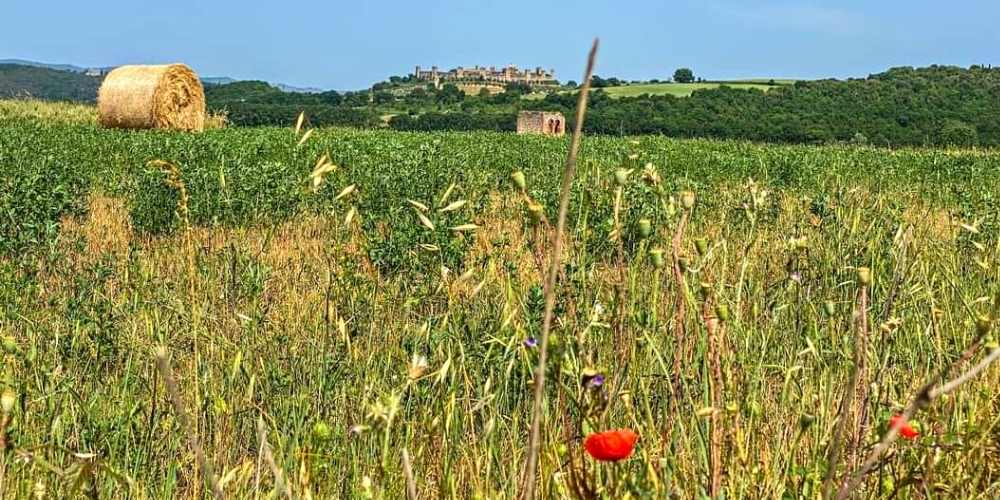
Elsa river park
If in itself Colle Val d'Elsa is not a particularly beautiful village, the Elsa river park is a magical place. The park begins just outside the town and consists of a walk of about an hour in a leafy wood furrowed by a very clean river that creates crystal-clear pools where it is possible to bathe.
The limestone conformation of the rocks gives this river a very special deep blue colour, so bright that one might doubt that it is natural (it is!). A few kilometres beyond the park you will find Le Caldane, thermal baths of Etruscan origin that still preserve their stone structure: here too you can refresh yourself with a dip in the crystal-clear waters.
When you reach Strove you will find yourself on the main Via Francigena, just in time to enjoy what is perhaps the most beautiful part of this stretch of the Via: the arrival in Monteriggioni.
As you approach the town you will cross blond fields of wheat dotted with hay sheaves and poppies: a true postcard of Tuscany. In the distance, you will see the hill on which the walled village stands approaching, and the suggestion of colours and scents will take you back in time, to a time when you had plenty of time to enjoy the view of your destination from afar and fully anticipate the moment of arrival.
Utopia is like the horizon: I walk two steps, and it recedes two steps. I walk ten steps, and it recedes ten steps. The horizon is unreachable. So, what is a utopia for? For this: it serves to keep walking.
Monteriggioni - Siena
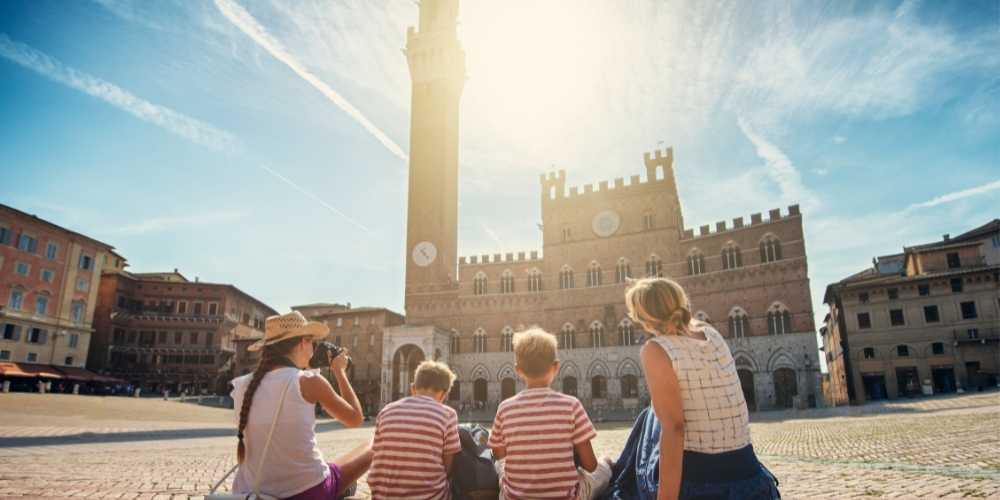
Siena
Once you get under the walls of Monteriggioni, the steep climb to reach the town awaits you: 10 intense minutes of steep ascent that will make you realise how this small village managed to resist the attacks of the Florentine armies for centuries. No army ever managed to take Monteriggioni: the town was only defeated due to the intervention of a deserter who surrendered the town to the enemy.
The village is a real fortified citadel, built by the Sienese to control the Via Cassia. Monteriggioni was chosen to be the seat of the Assassins in the famous video game Assassin's Creed: this has brought the village a further wave of video game tourism.
Beyond Monteriggioni, you enter the heart of the Sienese territory. Terra di Siena is a famous colour used in painting: if you don't remember exactly what shade it is, you absolutely must drive through these districts. The earth is an intense colour between red, brown and purple and makes an incredible contrast with the green of the grass and the yellow of the wheat.
You will arrive in Siena by crossing wheat fields dotted with parish churches and farmhouses, passing through woods of holm oaks and oaks, and seeing the beautiful Tuscan city growing larger and larger in the distance.
The route from Monteriggioni to Siena is not very long: it is about 14 km. The climb to Siena is undoubtedly steep, but as soon as you pass the city walls, you will find convenient escalators that will take you easily to the upper city. To recount the beauty of this city in a few lines is indeed a difficult task. For a more in-depth look, we recommend reading our article on the historical centre of Siena, a UNESCO World Heritage Site.
About the author
Written on 29/06/2022

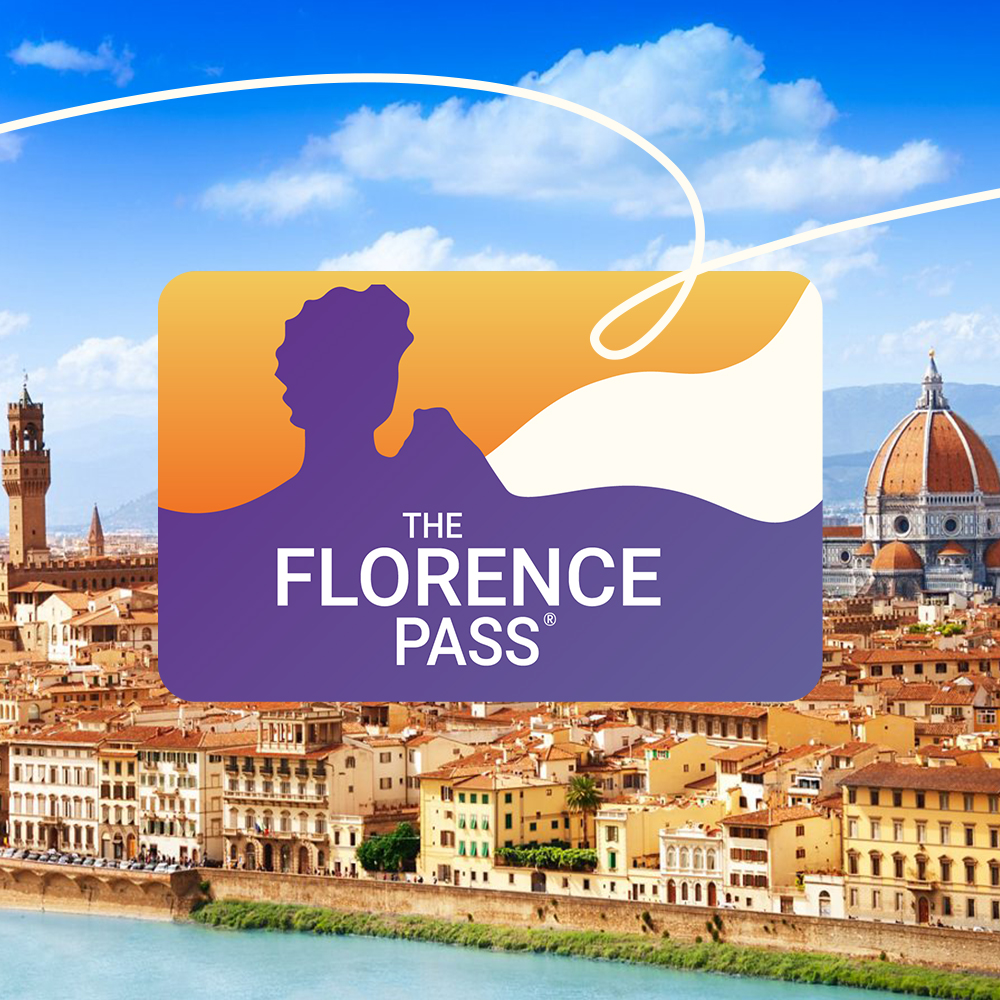
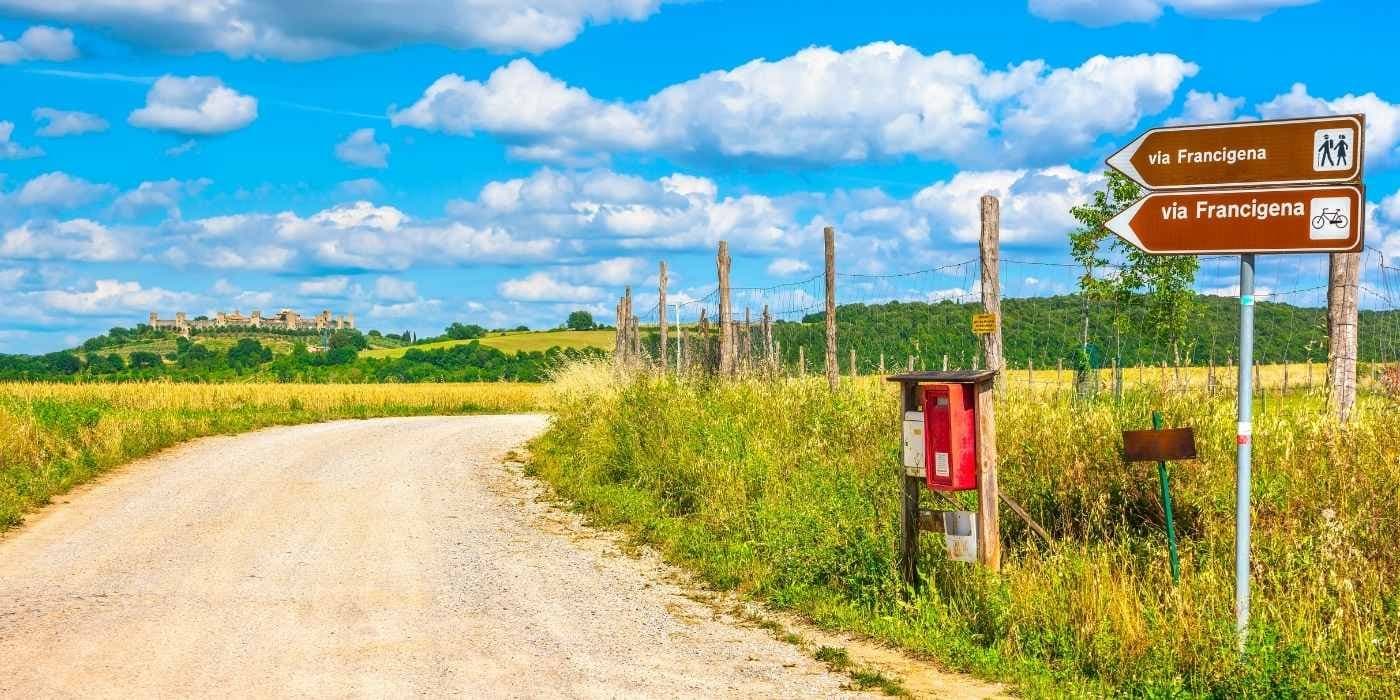

Gloria Venturini
Following Via Francigena, on the footsteps of the pilgrims, is a journey that will introduce you to one of the most enchanting corners of Tuscany